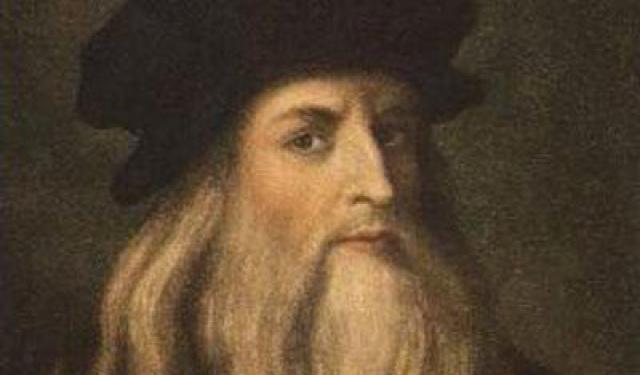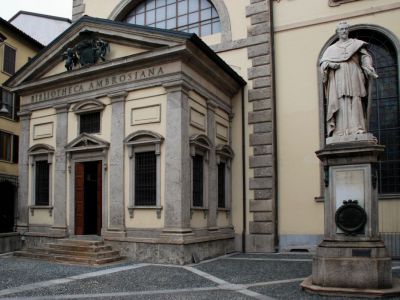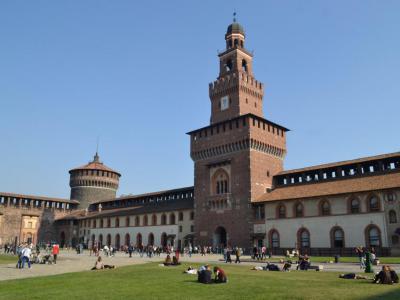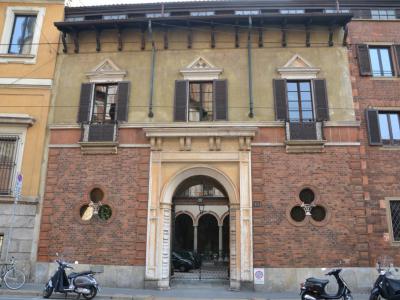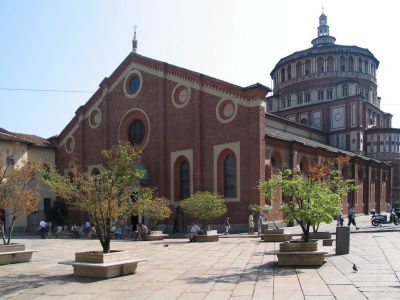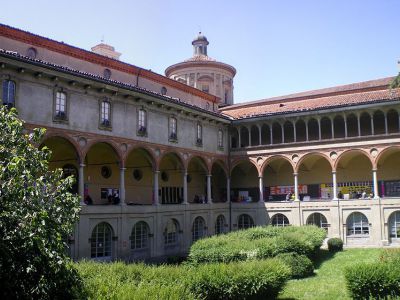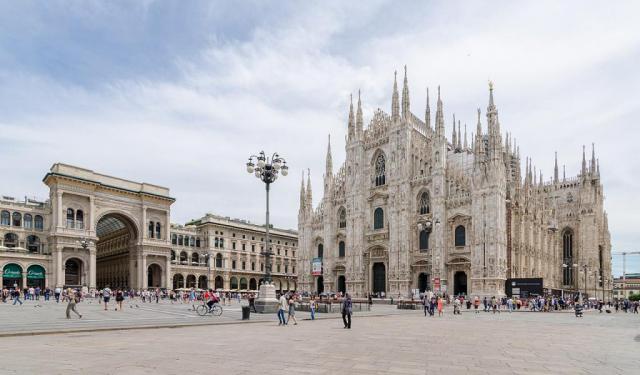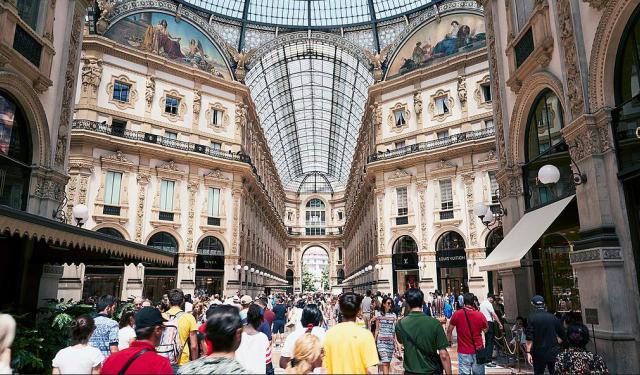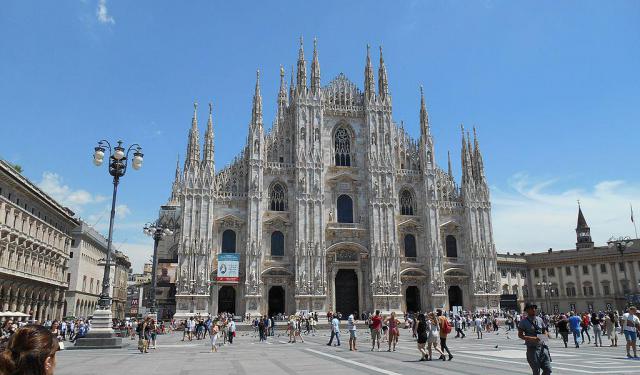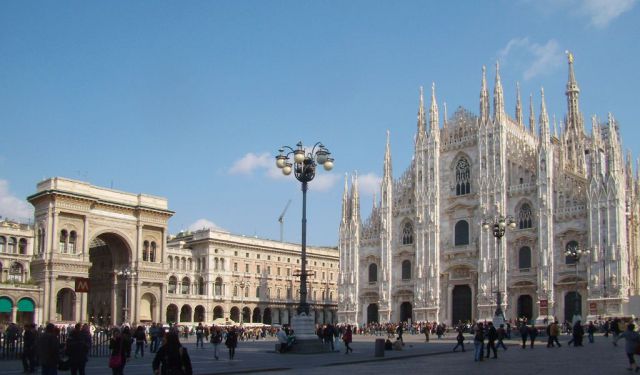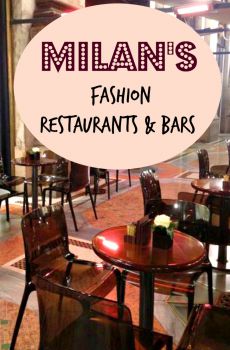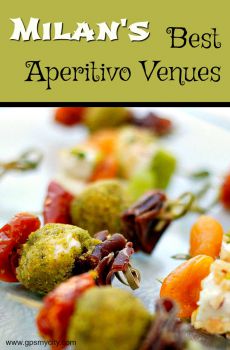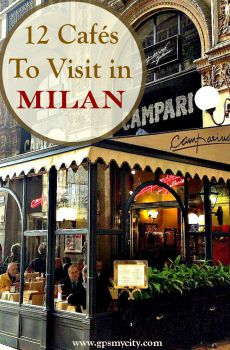Leonardo da Vinci's Masterpieces (Self Guided), Milan
Leonardo da Vinci, one of the greatest Renaissance artists and polymaths in history, left an indelible mark on Milan through several of his masterpieces created in this city over the nearly 20 years that he spent here.
One of the notable places where you can explore the maestro's work is the Ambrosian Library (Biblioteca Ambrosiana), which houses a vast collection of his drawings and manuscripts, offering insights into his inventive mind.
Another significant location tied to da Vinci is the Sforzesco Castle (Castello Sforzesco). This grand medieval fortress showcases the artist's ceiling fresco.
The Atellani House (Casa Atellani) is yet another place in Milan associated with da Vinci. Although not his paintings, this historic residence features the vineyard that Leonardo cherished and remained emotionally attached to long after he had left the city. It also offers a glimpse into the Milanese Renaissance lifestyle.
One of the most iconic masterpieces by da Vinci in Milan is located in the convent Church of Holy Mary of Grace (Chiesa di Santa Maria delle Grazie). "The Last Supper" fresco, a profound portrayal of the final meal of Jesus and his disciples, is an enduring symbol of his artistic brilliance. This fragile artwork, despite centuries of exposure and thanks to restoration efforts, remains a permanent draw for art enthusiasts.
To delve deeper into Leonardo's scientific and technological contributions, a visit to the Museum of Science and Technology (Museo della Scienza e della Tecnologia Leonardo da Vinci) is highly recommended. The museum houses a vast array of da Vinci's inventions and scientific endeavors, shedding light on his pioneering spirit and innovative thinking.
Given the abundance of da Vinci's contributions found in Milan, anyone drawn to artistry, engineering marvels, or technological innovations, will surely find a lot to explore. Take this self-guided walk for an opportunity to immerse yourself in the world of Leonardo da Vinci and gain a deeper appreciation for his enduring legacy.
One of the notable places where you can explore the maestro's work is the Ambrosian Library (Biblioteca Ambrosiana), which houses a vast collection of his drawings and manuscripts, offering insights into his inventive mind.
Another significant location tied to da Vinci is the Sforzesco Castle (Castello Sforzesco). This grand medieval fortress showcases the artist's ceiling fresco.
The Atellani House (Casa Atellani) is yet another place in Milan associated with da Vinci. Although not his paintings, this historic residence features the vineyard that Leonardo cherished and remained emotionally attached to long after he had left the city. It also offers a glimpse into the Milanese Renaissance lifestyle.
One of the most iconic masterpieces by da Vinci in Milan is located in the convent Church of Holy Mary of Grace (Chiesa di Santa Maria delle Grazie). "The Last Supper" fresco, a profound portrayal of the final meal of Jesus and his disciples, is an enduring symbol of his artistic brilliance. This fragile artwork, despite centuries of exposure and thanks to restoration efforts, remains a permanent draw for art enthusiasts.
To delve deeper into Leonardo's scientific and technological contributions, a visit to the Museum of Science and Technology (Museo della Scienza e della Tecnologia Leonardo da Vinci) is highly recommended. The museum houses a vast array of da Vinci's inventions and scientific endeavors, shedding light on his pioneering spirit and innovative thinking.
Given the abundance of da Vinci's contributions found in Milan, anyone drawn to artistry, engineering marvels, or technological innovations, will surely find a lot to explore. Take this self-guided walk for an opportunity to immerse yourself in the world of Leonardo da Vinci and gain a deeper appreciation for his enduring legacy.
How it works: Download the app "GPSmyCity: Walks in 1K+ Cities" from Apple App Store or Google Play Store to your mobile phone or tablet. The app turns your mobile device into a personal tour guide and its built-in GPS navigation functions guide you from one tour stop to next. The app works offline, so no data plan is needed when traveling abroad.
Leonardo da Vinci's Masterpieces Map
Guide Name: Leonardo da Vinci's Masterpieces
Guide Location: Italy » Milan (See other walking tours in Milan)
Guide Type: Self-guided Walking Tour (Sightseeing)
# of Attractions: 5
Tour Duration: 1 Hour(s)
Travel Distance: 2.5 Km or 1.6 Miles
Author: DanaOffice
Sight(s) Featured in This Guide:
Guide Location: Italy » Milan (See other walking tours in Milan)
Guide Type: Self-guided Walking Tour (Sightseeing)
# of Attractions: 5
Tour Duration: 1 Hour(s)
Travel Distance: 2.5 Km or 1.6 Miles
Author: DanaOffice
Sight(s) Featured in This Guide:
- Biblioteca Ambrosiana (Ambrosian Library & Art Gallery)
- Castello Sforzesco (Sforzesco Castle)
- Casa Atellani (Atellani House)
- Chiesa di Santa Maria delle Grazie (Church of Holy Mary of Grace); "The Last Supper" fresco
- Museo della Scienza e della Tecnologia Leonardo da Vinci (Museum of Science and Technology)
1) Biblioteca Ambrosiana (Ambrosian Library & Art Gallery) (must see)
In the bustling city of Milan, amidst its grandeur and energy, lies a place of quiet contemplation, the Ambrosiana Library and Art Gallery. Its origins date back to 1603 when local Cardinal Federico Borromeo, who had just returned from Rome's artistic circles, founded this sanctuary of knowledge and beauty. With over 36,000 manuscripts and more than 750,000 prints, the library is a true treasure trove of intellectual inquiry and spiritual reflection. Named after the patron saint of Milan, Ambrose, it is a testament to the intersection of religion, intellectualism, and aesthetics that defined the Renaissance period.
One of the main attractions here is the Codex Atlanticus, a collection of twelve volumes of drawings and manuscripts created by Leonardo da Vinci between 1478 and 1519. Containing the artist's drawings, sketches and fables, it is undoubtedly the largest collection of Leonardo's writings on practically every area of human knowledge: mechanics, mathematics, astronomy, botany, geography, physics, chemistry, architecture and philosophy.
Part of the library is the famous Pinacoteca Ambrosiana, the art gallery, featuring da Vinci's "Portrait of a Musician", Caravaggio's "Basket of Fruit", as well as Raffaello's life-size, pencil and carbon sketch of the "The School of Athens", a full-color final version of which is displayed in the Vatican.
Among other major acquisitions here are Islamic manuscripts, 11th-century diwan of poets and the oldest copy of the 'Kitab Sibawahaihi', plus a complete set of manuscripts from the Benedictine monastery of Bobbio (1606) and those from Vincenzo Pinelli of Padua, comprising more than 800 pieces, including the famous Ilias Picta (Ambrosian Iliad).
Why You Should Visit:
A chance to immerse yourself in the world of academic tomes and works of art, experience the tranquil ambiance that has enchanted scholars and art lovers for centuries, see art restorers at work on peculiar Renaissance masterpieces -- and in a brilliant building, too.
Tip:
On a weekday, you can practically have the entire place to yourself. The provided map/guide is quite clear, with all the main highlights identified, but if you're pressed for time, taking a guided tour is advisable.
One of the main attractions here is the Codex Atlanticus, a collection of twelve volumes of drawings and manuscripts created by Leonardo da Vinci between 1478 and 1519. Containing the artist's drawings, sketches and fables, it is undoubtedly the largest collection of Leonardo's writings on practically every area of human knowledge: mechanics, mathematics, astronomy, botany, geography, physics, chemistry, architecture and philosophy.
Part of the library is the famous Pinacoteca Ambrosiana, the art gallery, featuring da Vinci's "Portrait of a Musician", Caravaggio's "Basket of Fruit", as well as Raffaello's life-size, pencil and carbon sketch of the "The School of Athens", a full-color final version of which is displayed in the Vatican.
Among other major acquisitions here are Islamic manuscripts, 11th-century diwan of poets and the oldest copy of the 'Kitab Sibawahaihi', plus a complete set of manuscripts from the Benedictine monastery of Bobbio (1606) and those from Vincenzo Pinelli of Padua, comprising more than 800 pieces, including the famous Ilias Picta (Ambrosian Iliad).
Why You Should Visit:
A chance to immerse yourself in the world of academic tomes and works of art, experience the tranquil ambiance that has enchanted scholars and art lovers for centuries, see art restorers at work on peculiar Renaissance masterpieces -- and in a brilliant building, too.
Tip:
On a weekday, you can practically have the entire place to yourself. The provided map/guide is quite clear, with all the main highlights identified, but if you're pressed for time, taking a guided tour is advisable.
2) Castello Sforzesco (Sforzesco Castle) (must see)
Castello Sforzesco, one of the largest fortresses in Europe, was originally built in the 14th century to house the Duchy of Milan. Despite its long history of battles, invasions, sacking and destruction, the castle has endured and been restored many times. One of its towers, the Filarete tower, once used to store ammunition, famously exploded in 1521 after being struck by lightning, causing many casualties and significant damage to the fortress.
During the Napoleonic era, the castle was severely damaged and used as quarters for troops, including stables in the frescoed rooms on the ground floor of the Corte Ducale. However, following Italy's Unification in the late 19th century, the castle was reconstructed by architect Luca Beltrami and returned to the city of Milan in 1905. Today, it is a prominent hub of art and culture, boasting seven museums accessible to the public.
The interior of is adorned with exquisitely detailed works of art, notably the intricate ceiling fresco in the magnificent Sala delle Asse, painted by Leonardo da Vinci, who was commissioned by his patrons, the Sforza family. The fresco depicts a pergola in a garden with 16 mulberry trees held together by a golden rope.
Why You Should Visit:
Each room herein is a treasure, not only for the exhibited items, but also for the ceiling frescoes which are wonders in their own right.
Entrance to the castle is free, so if you're on a budget, just walk through and admire the courtyards and architecture. As for the "all museums" fee, it is quite reasonable.
Tip:
Exploring the entire Castello Sforzesco, complete with its gardens, may take a few days.
Try to go on Tuesday around 2pm to get free entry (entry on the 1st and 3rd Tuesday of every month is free for all public museums).
There's no way to access the battlements or the "inside" (aside from the museums) except by a guided tour, so consider booking one in advance.
During the Napoleonic era, the castle was severely damaged and used as quarters for troops, including stables in the frescoed rooms on the ground floor of the Corte Ducale. However, following Italy's Unification in the late 19th century, the castle was reconstructed by architect Luca Beltrami and returned to the city of Milan in 1905. Today, it is a prominent hub of art and culture, boasting seven museums accessible to the public.
The interior of is adorned with exquisitely detailed works of art, notably the intricate ceiling fresco in the magnificent Sala delle Asse, painted by Leonardo da Vinci, who was commissioned by his patrons, the Sforza family. The fresco depicts a pergola in a garden with 16 mulberry trees held together by a golden rope.
Why You Should Visit:
Each room herein is a treasure, not only for the exhibited items, but also for the ceiling frescoes which are wonders in their own right.
Entrance to the castle is free, so if you're on a budget, just walk through and admire the courtyards and architecture. As for the "all museums" fee, it is quite reasonable.
Tip:
Exploring the entire Castello Sforzesco, complete with its gardens, may take a few days.
Try to go on Tuesday around 2pm to get free entry (entry on the 1st and 3rd Tuesday of every month is free for all public museums).
There's no way to access the battlements or the "inside" (aside from the museums) except by a guided tour, so consider booking one in advance.
3) Casa Atellani (Atellani House)
Behold Casa Atellani, an awe-inspiring 15th-century palace located in the heart of Milan. During the reign of Ludovico Maria Sforza, regent of the Duchy of Milan, he generously granted building permits to his courtiers and collaborators to construct lavish buildings along the road axis of the ancient village of Porta Vercellina. The Atellani family, one of the privileged courtiers, purchased this palace from the Landi counts of Piacenza in 1490, and the Duke donated it to them. The palace was famous for the sumptuous parties thrown by the Atellanis, which attracted the most prominent personalities of the Sforza court, and the tales of their grandeur were documented in several chronicles of that era.
Besides featuring 15th-century frescoes, coats of arms, and paintings, this palace also boasts of neoclassical elements dating back to the 1920s restoration executed by the iconic architect Piero Portaluppi. Regrettably, the palace was severely damaged during the Second World War by air raids; however, its glorious garden, which encompasses the renowned Da Vinci's Vineyard, has endured the ravages of time.
When Leonardo da Vinci was working on The Last Supper mural, he lodged in Casa Atellani. The Duke gifted the property's vineyard, a rectangular plot of 60x175 meters, to the artist in 1498 as a tribute to his prodigious talent. Being from a family of winemakers, Leonardo cherished this vineyard, and even after he left Milan, he remained emotionally attached to it.
During the Expo 2015, the University of Milan collaborated with the Casa Atellani administration to replant Leonardo's vineyard. The replanting was based on the DNA analysis of the remains of the Malvasia di Candia Aromatica vines, a white grape variety that was popular during the Renaissance period, discovered during excavations. This was done in an attempt to recreate the wine that Leonardo may have tasted himself.
A visit to the vineyard is undoubtedly a must-do activity while in Da Vinci's Milan. However, one needs to book in advance to witness the glory of this living history.
Besides featuring 15th-century frescoes, coats of arms, and paintings, this palace also boasts of neoclassical elements dating back to the 1920s restoration executed by the iconic architect Piero Portaluppi. Regrettably, the palace was severely damaged during the Second World War by air raids; however, its glorious garden, which encompasses the renowned Da Vinci's Vineyard, has endured the ravages of time.
When Leonardo da Vinci was working on The Last Supper mural, he lodged in Casa Atellani. The Duke gifted the property's vineyard, a rectangular plot of 60x175 meters, to the artist in 1498 as a tribute to his prodigious talent. Being from a family of winemakers, Leonardo cherished this vineyard, and even after he left Milan, he remained emotionally attached to it.
During the Expo 2015, the University of Milan collaborated with the Casa Atellani administration to replant Leonardo's vineyard. The replanting was based on the DNA analysis of the remains of the Malvasia di Candia Aromatica vines, a white grape variety that was popular during the Renaissance period, discovered during excavations. This was done in an attempt to recreate the wine that Leonardo may have tasted himself.
A visit to the vineyard is undoubtedly a must-do activity while in Da Vinci's Milan. However, one needs to book in advance to witness the glory of this living history.
4) Chiesa di Santa Maria delle Grazie (Church of Holy Mary of Grace); "The Last Supper" fresco (must see)
Santa Maria delle Grazie (the Church of Holy Mary of Grace) is a world-famous church and Dominican convent in Milan, included in the UNESCO World Heritage sites list. The Duke of Milan, Francesco I Sforza, ordered the building of Santa Maria delle Grazie in the 15th century. The design of its apse has been attributed to Donato Bramante, who at that time was in the service of the Duchy. While adhering to the overall Gothic style of the convent, he added some Romanesque touches as well.
The church is primarily famous for the mural of The Last Supper (Il Cenacolo Vinciano) found in the refectory of the convent. Created by Leonardo da Vinci for his patron Duke Ludovico Sforza and the Duchess, this 15th-century wall painting was made on a dry wall rather than on wet plaster, and, thus, is not truly a fresco. A fresco cannot be altered as the artist works; therefore, Leonardo decided to paint on the stone wall and then cover it with a sealing layer. The work began to deteriorate a few years after he had finished it. Two early copies of "The Last Supper", thought to be the work of Leonardo's assistant, still exist.
During World War II, on the night of 15 August 1943, an allied aerial bombardment hit the church and the convent. Much of the refectory was destroyed, but some walls survived, including the one holding "The Last Supper", which had been sand-bagged for protection. The preservation works continuously done ever since, and hopefully in the future, are believed to maintain this painting intact for many centuries to come.
Why You Should Visit:
Viewing "The Last Supper" in its own setting will make you feel more appreciative of the single point linear perspective and the 3D effect so cleverly used by Da Vinci.
Tip:
To view "The Last Supper", make sure to book your tickets well in advance on the official website, as they are usually sold out within at least two weeks prior to the sought date.
The church is primarily famous for the mural of The Last Supper (Il Cenacolo Vinciano) found in the refectory of the convent. Created by Leonardo da Vinci for his patron Duke Ludovico Sforza and the Duchess, this 15th-century wall painting was made on a dry wall rather than on wet plaster, and, thus, is not truly a fresco. A fresco cannot be altered as the artist works; therefore, Leonardo decided to paint on the stone wall and then cover it with a sealing layer. The work began to deteriorate a few years after he had finished it. Two early copies of "The Last Supper", thought to be the work of Leonardo's assistant, still exist.
During World War II, on the night of 15 August 1943, an allied aerial bombardment hit the church and the convent. Much of the refectory was destroyed, but some walls survived, including the one holding "The Last Supper", which had been sand-bagged for protection. The preservation works continuously done ever since, and hopefully in the future, are believed to maintain this painting intact for many centuries to come.
Why You Should Visit:
Viewing "The Last Supper" in its own setting will make you feel more appreciative of the single point linear perspective and the 3D effect so cleverly used by Da Vinci.
Tip:
To view "The Last Supper", make sure to book your tickets well in advance on the official website, as they are usually sold out within at least two weeks prior to the sought date.
5) Museo della Scienza e della Tecnologia Leonardo da Vinci (Museum of Science and Technology) (must see)
The National Museum of Science and Technology “Leonardo da Vinci” in Milan, inaugurated on February 15, 1953, stands as one of Europe’s foremost institutions dedicated to scientific and technological culture. Initially founded as “Technics,” it now operates as a private law foundation supported by ministries, public bodies, and Milanese universities.
The museum’s permanent exhibitions reveal the breadth of human invention across centuries. The Leonardo da Vinci Galleries, spanning 1,300 square meters, form the world’s largest display devoted to Da Vinci as both engineer and humanist. Through 170 models, artworks, and manuscripts, visitors trace his life from 15th-century Florence to Milan, exploring his ideas on flight, war, architecture, and waterways. The galleries reinterpret Da Vinci’s genius as a dialogue between art and science, celebrating his enduring curiosity and interdisciplinary thinking.
Other sections highlight Italy’s industrial and creative mastery. The Classic Cars exhibition honors Italian craftsmanship through models like the 1903 Bianchi 8HP and the Alfa Romeo 8C series, presented in a reflective red-lit setting that transforms them into “sculptures in motion.” Each car tells a story of innovation, from early automobile pioneers to experimental postwar designs such as the 1955 Bisiluro DaMolNar.
The museum also explores major transport revolutions. The Air Transport section recounts Lombardy’s pioneering role in aviation—from Enrico Forlanini’s 1877 helicopter to World War II aircraft—while Rail Transport showcases early steam and electric locomotives that connected industrial Italy. The Naval Transport collection, one of Italy’s richest, features over 3,300 artifacts including the submarine Enrico Toti and the training ship Ebe.
Further exhibits bridge science and art. The Music and Theatre section displays part of Teatro alla Scala’s historic hydraulic stage, instruments from the nineteenth century, and early sound devices like Edison phonographs. In turn, the Space exhibition invites visitors to engage with cosmic exploration—from ancient astronomy to modern missions—featuring Italy’s only fragment of lunar rock. Together, these galleries embody the museum’s mission: to preserve the past, inspire curiosity, and connect scientific progress with human imagination.
The museum’s permanent exhibitions reveal the breadth of human invention across centuries. The Leonardo da Vinci Galleries, spanning 1,300 square meters, form the world’s largest display devoted to Da Vinci as both engineer and humanist. Through 170 models, artworks, and manuscripts, visitors trace his life from 15th-century Florence to Milan, exploring his ideas on flight, war, architecture, and waterways. The galleries reinterpret Da Vinci’s genius as a dialogue between art and science, celebrating his enduring curiosity and interdisciplinary thinking.
Other sections highlight Italy’s industrial and creative mastery. The Classic Cars exhibition honors Italian craftsmanship through models like the 1903 Bianchi 8HP and the Alfa Romeo 8C series, presented in a reflective red-lit setting that transforms them into “sculptures in motion.” Each car tells a story of innovation, from early automobile pioneers to experimental postwar designs such as the 1955 Bisiluro DaMolNar.
The museum also explores major transport revolutions. The Air Transport section recounts Lombardy’s pioneering role in aviation—from Enrico Forlanini’s 1877 helicopter to World War II aircraft—while Rail Transport showcases early steam and electric locomotives that connected industrial Italy. The Naval Transport collection, one of Italy’s richest, features over 3,300 artifacts including the submarine Enrico Toti and the training ship Ebe.
Further exhibits bridge science and art. The Music and Theatre section displays part of Teatro alla Scala’s historic hydraulic stage, instruments from the nineteenth century, and early sound devices like Edison phonographs. In turn, the Space exhibition invites visitors to engage with cosmic exploration—from ancient astronomy to modern missions—featuring Italy’s only fragment of lunar rock. Together, these galleries embody the museum’s mission: to preserve the past, inspire curiosity, and connect scientific progress with human imagination.
Walking Tours in Milan, Italy
Create Your Own Walk in Milan
Creating your own self-guided walk in Milan is easy and fun. Choose the city attractions that you want to see and a walk route map will be created just for you. You can even set your hotel as the start point of the walk.
Historical Churches Walking Tour
Milan may well be a world fashion capital and one of the financial capitals of Europe, but religion, and particularly churches, are an inseparable part of the Milanese life. Indeed, steeped in history, this city has garnered over the centuries a wealth of iconic places of worship.
Among these, the Milan Cathedral (Duomo di Milano) stands as a symbol of grandeur and faith. This magnificent... view more
Tour Duration: 2 Hour(s)
Travel Distance: 3.1 Km or 1.9 Miles
Among these, the Milan Cathedral (Duomo di Milano) stands as a symbol of grandeur and faith. This magnificent... view more
Tour Duration: 2 Hour(s)
Travel Distance: 3.1 Km or 1.9 Miles
Best Shopping Streets and Malls
One of the world's four fashion capitals and, as of lately, that of industrial design as well, Milan is renowned internationally as a top shopping destination, where fashion is the second religion. In a city as rich as this one, dedicated to art and pleasure, there's no shortage of options for those accustomed to upscale shopping and favoring bargains.
Amid the plethora of places to... view more
Tour Duration: 2 Hour(s)
Travel Distance: 3.4 Km or 2.1 Miles
Amid the plethora of places to... view more
Tour Duration: 2 Hour(s)
Travel Distance: 3.4 Km or 2.1 Miles
Milan Introduction Walking Tour
Recognized as one of the world's four fashion capitals, Milan is also a global hub of design and a key tourist destination. The etymology of the name Milan remains uncertain. One theory holds that the Latin name Mediolanum comes from the Latin words medio (in the middle) and planus (plain).
In 286 the Roman Emperor Diocletian moved the capital of the Western Roman Empire from Rome to... view more
Tour Duration: 2 Hour(s)
Travel Distance: 3.9 Km or 2.4 Miles
In 286 the Roman Emperor Diocletian moved the capital of the Western Roman Empire from Rome to... view more
Tour Duration: 2 Hour(s)
Travel Distance: 3.9 Km or 2.4 Miles
Historic Center Walking Tour
Contained within the area once delimited by the medieval walls, the Centro Storico (historic center) of Milan encompasses the city's perhaps most famous landmarks and tourist attractions. Compact in size, the area is easily distinguishable on the map much as walkable. Here you can find almost everything Milan is famous for, in a close proximity to each other.
The best place to start is... view more
Tour Duration: 2 Hour(s)
Travel Distance: 2.5 Km or 1.6 Miles
The best place to start is... view more
Tour Duration: 2 Hour(s)
Travel Distance: 2.5 Km or 1.6 Miles
Useful Travel Guides for Planning Your Trip
Souvenir Shopping Guide: 16 Italian Goods Worth Buying in Milan
Needless to say much about Milan and the things the city is famous for. From fashion and luxury to football and Berlusconi, the list is long. Still, some of the distinctively Milanese items may pass unnoticed to the eye of a stranger, if not caringly pointed in the right direction by a knowledgeable...
Milan's Fashion Restaurants & Bars
Milan is a city well known for luxurious fashion and shopping. With this guide your designer experience doesn't have to end at the stores and boutiques. Almost every major Italian fashion house (as well as a few foreign ones) has entered the food, beverage, or hospitality businesses in Milan,...
Sweet Shops of Milan
This guide will undoubtably make your trip to Milan a sweet one. Most locations are in the city centre, whilst others are set in older headquarters, that boast incredible landmarks and hidden beauties. Milan is habitually associated to fashion and business but has some exquisite examples of art...
Milan's Best Aperitivo Venues
Apéritifs usually are alcoholic drinks that are normally served before a meal. But in Milan the Aperitivo can actually become a fun, cheap (but not unchic) dinner with friends or (in a romantic venue) with a date. The all-you-can-eat formula allows you to buy just one drink and serve yourself with...
10 Cafes To Visit in Milan
The industrial capital of Italy and one of the world's fashion and business centers, today's Milan is teeming with chaotic urban rush on a daily basis. Although it can't compete with Rome in terms of history, art and architecture, there are hidden gems in Milan well worth searching...
16 Best Pastry Shops in Milan Italy
Are you looking to satisfy your sweet tooth with genuine, locally-made Italian pastries and drink real “espresso”? This guide covers the best pastry shops/cafes in Milan, the capital of fashion and excellent northern Italian food. Places where one can drink coffee or tea and eat some of the...
The Most Popular Cities
/ view all
